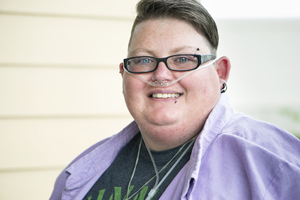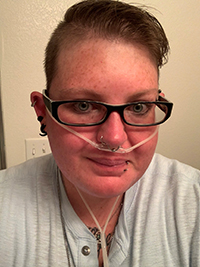From Breathlessness to Hopefulness: Living with Pulmonary Hypertension
 Kira Cronk was 30 when she first went to the hospital with shortness of breath. She had emergency surgery to remove a blood clot, but three months later was still struggling to breathe.
Kira Cronk was 30 when she first went to the hospital with shortness of breath. She had emergency surgery to remove a blood clot, but three months later was still struggling to breathe.
Cronk's breathlessness persisted, and she was diagnosed with congestive heart failure.
"They kept telling me it was a weight issue," she said. "I was going crazy because I was doing everything I could to lose weight and nothing was happening."
More tests revealed the possibility of an autoimmune disease, prompting her doctor to suggest that she see a specialist. “My mom stepped in and said, 'You request National Jewish Health,’” Cronk said. "A family friend had gone there and just raved about them."
Interdisciplinary Approach Leads to Diagnosis
Roughly three years after she first started having symptoms, Cronk believed she was finally close to a diagnosis — until her tests for autoimmune disease came back negative. She feared she would once again be sent home without answers or a way to effectively manage her symptoms. But as part of the interdisciplinary approach at National Jewish Health and their close relationship with Saint Joseph Hospital, Cronk received a series of cardiac tests, including right heart catheterization, a walking test and an electrocardiogram (EKG).
Her right heart catheterization revealed pressure in her lungs and she was diagnosed with idiopathic arterial pulmonary hypertension.
"All these other doctors did was look at me and see a weight problem,” Cronk said. “National Jewish Health was the first place to look beyond that. If it wasn't for them, I think my heart would have just given out."
Partnership Delivers Improved Care, Innovative Treatment
Cronk is now managing her condition through outpatient visits at National Jewish Health and inpatient care at Saint Joseph Hospital. The clinical partnership between the two hospitals improves the quality of her care, she explained. "They're so in sync when it comes to communication.” Hospitalists like Carrie Horn, MD, of National Jewish Health "keep everyone on the same page," she said.
For years, hospital stays brought Cronk frustration and more questions than answers. Saint Joseph Hospital is different, she explained. “I can’t say enough wonderful things about Saint Joe’s. It’s the only hospital where I’ll be admitted now,” she said. “They have the most wonderful nurses. They treat me like it’s home."
"It's really a team approach," said M. Patricia George, MD, a pulmonologist at National Jewish Health and part of Cronk's care team. When Cronk’s oral medications caused her condition to worsen, Dr. George reached out to numerous leading hospitals to see if they had converted patients on Cronk’s particular drug regimen to medication administered subcutaneously, or under the skin. Finding no such precedent, Dr. George worked with colleagues at Saint Joseph Hospital and the University of Pittsburgh Medical Center to create a protocol that allows Cronk to take her life-saving medication through a pump.
Cronk found the device intimidating at first. “Now I’m a pro,” she said.
Making the Patient Part of the Team
In addition to innovative drug therapies, patient education is a critical part of the program. Despite doctors telling her for years that she needed to lose weight, Cronk had never been educated on the role that sodium plays in diet and pulmonary hypertension until she went to National Jewish Health.
Dr. George credits "a really, really dedicated team of nurses" at National Jewish Health for going above and beyond in educating patients and following up with them. "We try to help patients view themselves as part of the team and key to getting better," said Dr. George.
Cronk has embraced that role. "She's really inspirational to me as a patient,” said Dr. George. “She has a serious disease and her life has lots of stresses, but she doesn't give up. She's a superstar in my mind."
Living with pulmonary hypertension is "a balancing act with some difficult days," said Cronk. But she is determined not to let the disease define her. "My job is to be kind and good, and make people smile," she said. "I'm not going to let a lung disease change that."
Personalized Care and the Drive to Lose Weight
 As Cronk continued to work with her care team, she began to focus on losing weight. She considered bariatric surgery, but due to her pulmonary hypertension and congestive heart failure, Cronk was not a candidate. Instead of giving up, Cronk turned her frustration into momentum.
As Cronk continued to work with her care team, she began to focus on losing weight. She considered bariatric surgery, but due to her pulmonary hypertension and congestive heart failure, Cronk was not a candidate. Instead of giving up, Cronk turned her frustration into momentum.
“With the help of Dr. George and Michelle MacDonald, my clinical dietitian, I started a loose version of the Ketogenic diet,” Cronk said. She began by cutting out soda and sugar, then junk foods and take-out meals. The biggest change was learning to cook her own meals. “It’s so much easier to control what you’re eating when you’re making it yourself.”
With just small changes, Cronk has lost 160 pounds in the past two years. As Cronk lost weight, her pulmonary pressures and heart function improved, and she no longer requires dialysis. She also regained so much mobility and function that she no longer requires a caregiver or wheel chair to help her get around.
“I can’t stress enough how much support Michelle and Dr. George have given me. They’re fantastic,” Cronk said. Cronk looks forward to losing more weight as she begins physical rehabilitation, and, most importantly, spending more meaningful time with her daughter, Hannah.

